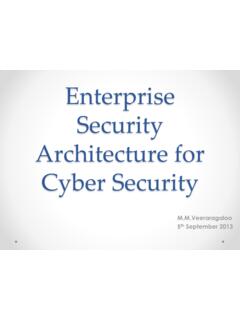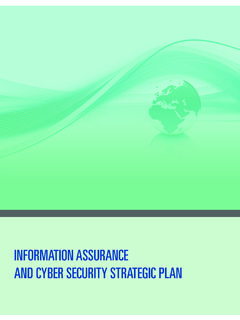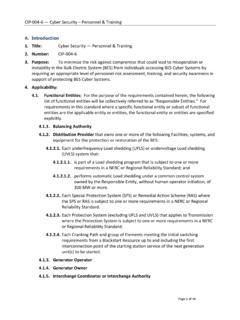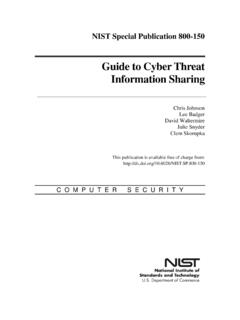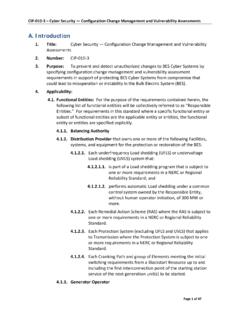Transcription of Regulatory approaches to enhance banks’ cyber-security ...
1 Financial Stability Institute FSI Insights on policy implementation No 2. Regulatory approaches to enhance banks'. cyber - security frameworks By Juan Carlos Crisanto and Jermy Prenio August 2017. FSI Insights are written by members of the Financial Stability Institute (FSI) of the Bank for International Settlements (BIS), often in collaboration with staff from supervisory agencies and central banks. The papers aim to contribute to international discussions on a range of contemporary Regulatory and supervisory policy issues and implementation challenges faced by financial sector authorities. The views expressed in them are solely those of the authors and do not necessarily reflect those of the BIS or the Basel-based Committees. Authorised by the Chairman of FSI, Fernando Restoy. This publication is available on the BIS website ( ). To contact the BIS Media and Public Relations team, please e-mail You can sign up for e-mail alerts at Bank for International Settlements 2017.
2 All rights reserved. Brief excerpts may be reproduced or translated provided the source is stated. ISSN 2522-2481 (print). ISBN 978-92-9259-089-5 (print). ISSN 2522-249X (online). ISBN 978-92-9259-080-2 (online). Contents Executive summary .. 1. Introduction .. 3. Developing specific regulations for cyber -risk .. 4. Existing key Regulatory requirements relating to cyber -risk .. 5. Supervisory frameworks and tools .. 9. Observations about the implementation of cyber -risk regulations by the banking industry .. 11. Some policy considerations .. 14. References .. 16. Regulatory approaches to enhance banks' cyber - security frameworks iii Regulatory approaches to enhance banks' cyber - security frameworks 1. Executive summary Recent high-profile cyber -attacks on financial institutions have focused attention on the need to strengthen cyber - security . Among financial institutions, banks have the most public-facing products and services, and are thus significantly vulnerable to cyber -attacks.
3 Consequently, cyber -risk is a major concern for most bank supervisors. However, only a handful of jurisdictions have specific Regulatory and supervisory initiatives on banks' cyber -risk; these include Hong Kong SAR, Singapore, the United Kingdom and the United States. This paper therefore focuses on these jurisdictions in particular in its analysis of emerging Regulatory and supervisory frameworks, with a view to drawing more general conclusions. Views differ on the need to specifically regulate cyber -risk. One view is that the evolving nature of cyber -risk is not amenable to specific regulation and that cyber issues can be handled with existing regulation relating to technology and/or operational risk. The other view is that Regulatory structure is needed to deal with the unique nature of cyber -risk, and given the growing threats resulting from an increasingly digitised financial sector.
4 For jurisdictions that already have specific Regulatory requirements, a debate continues about the optimal level of prescriptiveness. Some jurisdictions favour a principles-based approach while others apply a more prescriptive framework. Despite these differences, the usual starting point for a cyber - security Regulatory setup is to require banks to have a documented cyber - security programme or policy. Banks are expected to identify critical information assets that need to be protected. Testing banks'. vulnerability and resilience to cyber -risk (such as through penetration testing) is a common requirement, as well as the reporting of cyber -events. Another common requirement relates to having clear responsibilities and accountabilities at banks as a key component of their cyber - security framework. Less common Regulatory requirements include cyber -threat intelligence-sharing (although it is generally encouraged).
5 The security capabilities of third-party providers are a critical element of any cyber - security framework but the specific supervisory approaches depend on the extent to which third parties are covered by the powers of bank supervisors. Supervisory approaches specifically developed to assess the soundness of banks' cyber - security are still evolving. cyber - security continues to be assessed largely as part of the ongoing risk-based supervisory framework and, more recently, this has been complemented by thematic reviews. However, supervisors seem to be converging towards undertaking a so-called threat-informed or intelligence- led testing framework, ie by using threat intelligence to design simulated cyber -attacks to test a bank's cyber - security . Also, it should be noted that an approach taken by some supervisors is to certify the information security professionals used by banks for their cyber - security activities.
6 Attracting and retaining staff with cyber /information security expertise is a key challenge for supervisory authorities worldwide. There is also scope to increase the level of cooperation and coordination among supervisors from different jurisdictions and financial sectors. Based on the range of practice it reviews, the paper offers some high-level policy considerations, which may be helpful for banking supervisory authorities contemplating or planning to introduce or enhance their cyber - security banking regulations or supervisory tools. These are, first, to 1. Juan Carlos Crisanto, Jermy Prenio, Bank for International Settlements. The authors are grateful to David Whyte, Head of BIS cyber - security , for useful comments and suggestions, as well as to the financial sector authorities and industry participants who shared their perspectives on the issue. Regulatory approaches to enhance banks' cyber - security frameworks 1.
7 Incorporate cyber -risk, like any other bank risk, into the enterprise-wide risk management framework and governance requirements of supervised banking institutions. Second, to require banks to develop an effective control and response frameworks for cyber -risk, including ensuring the implementation of general sound risk management practices in the context of cyber -risk. Third, to consider as starting points the existing technical standards on cyber - and information security for any regulation relating to cyber - risk. Fourth, to put more emphasis in promoting cyber - security awareness among bank staff. Fifth, to benefit from further collaboration with the industry in strengthening banks' cyber - security . And, sixth, to pursue greater cross-border cooperation and consistency in Regulatory and supervisory approaches to enhance cyber -resilience at banks. 2 Regulatory approaches to enhance banks' cyber - security frameworks Introduction 1.
8 Recent high-profile cyber -attacks on financial institutions have focused attention on the need to strengthen cyber - security , leading to various official sector initiatives to address cyber -risk. At the international level, the G7 finance ministers and central bank governors issued a set of Fundamental elements of cybersecurity for the financial sector, with the aim of helping banks tailor their cyber - security approaches to their operational and Regulatory environment. 2 The Financial Stability Board (FSB) included in its 2017 workplan 3 the need to monitor cyber -risk arising from financial technology (fintech) and to identify the supervisory and Regulatory issues from a financial stability perspective. The FSB's report for the July 2017 G20 Hamburg summit 4 places the need to mitigate the adverse impact of cyber -risk on financial stability among the top three priority areas for future international cooperation.
9 In June 2016, the Committee on Payments and Market Infrastructures (CPMI) and the International Organization of Securities Commissions (IOSCO) issued Guidance on cyber resilience for financial market infrastructures. 5. In April 2016, the International Association of Insurance Supervisors (IAIS) published an issues paper to raise awareness among insurers and supervisors of the challenges presented by cyber -risk. 6. 2. This increased attention to cyber -risk is not confined to the larger economies. In 2016, the FSI conducted a survey of banking supervisors in 73 non-Basel Committee jurisdictions worldwide. 7 In identifying their main macroeconomic and financial stability challenges, most respondents cited fintech and the resulting cyber -risk as their top challenge. 3. These concerns are shared by the industry. The Deloitte's 2016 Global Risk Management Survey indicated that only 42 percent of respondents 8 considered their institution to be extremely or very effective in managing cyber -risk.
10 Yet, cyber -risk is the risk type that respondents most often ranked among the top three that would increase in importance over the next two years (41 percent) . 9 In January 2017, ranked cyber -risk as the topmost among the top 10 operational risks for 2017. This ranking was based on interviews with chief risk officers, heads of operational risk and other operational risk practitioners at financial institutions, including banks, insurance firms and asset managers. 10. 4. The CPMI-IOSCO Guidance defines cyber -risk as the combination of the probability of an event occurring within the realm of an organisation's information assets, computer and communication resources and the consequences of that event for an organisation . 11 By this definition, any organisation (or person) with information assets and uses online communications technology is exposed to cyber -risk. Indeed, the advent of information technology (IT) has made interconnections of people and organisations within and across economies pervasive, and with this comes the heightened risk of cyber -attacks.










